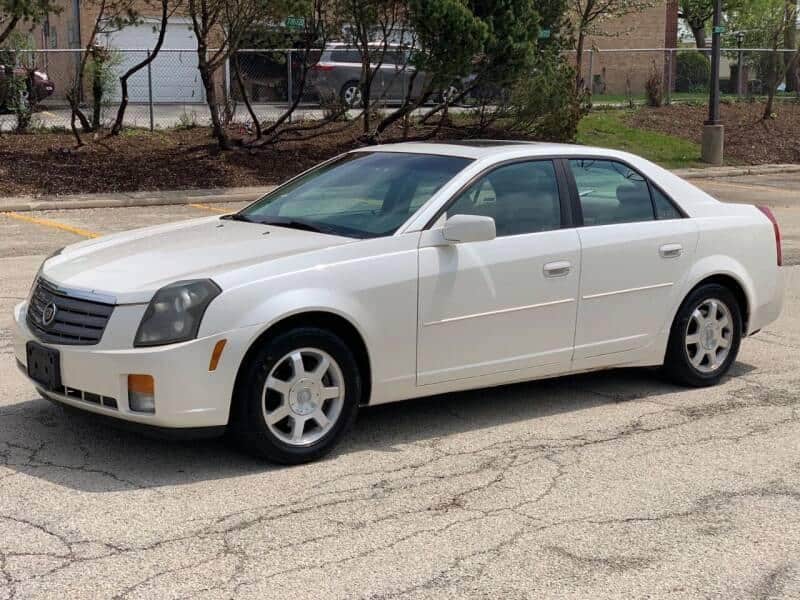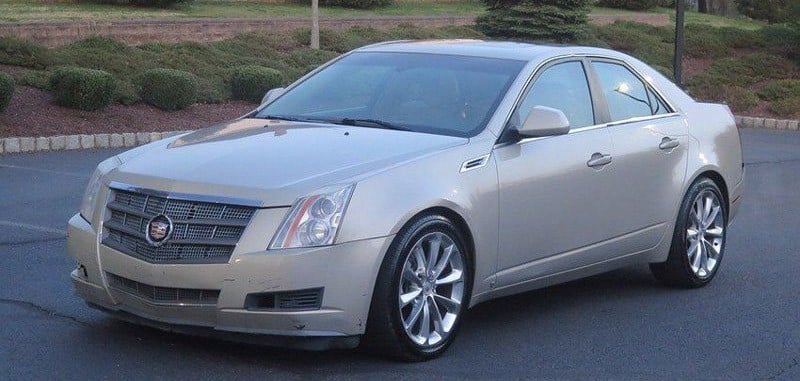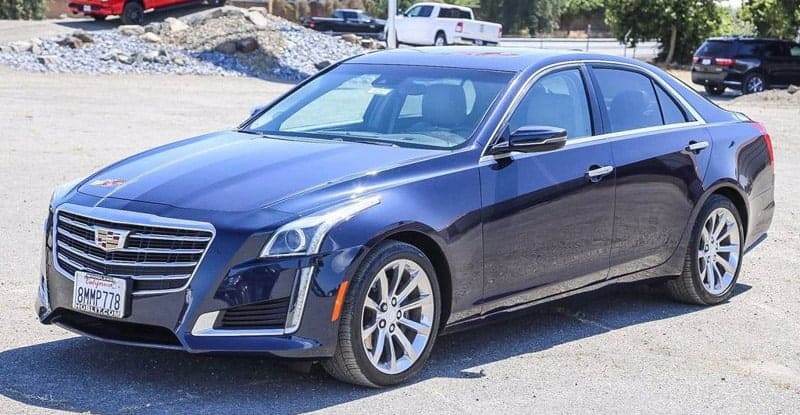What to Look For When Buying a Used Cadillac CTS
We might not be able to buy a brand new Cadillac CTS anymore but there are plenty of pre-owned Cadillac CTS models on lots for sale around the country. The CTS is a midsize sedan that always had an uphill struggle to attract buyers away from its incredibly successful, popular and highly regarded German rivals, but it really did give it a good shot. The Cadillac CTS comes in several different guises and they can be an attractive proposition to an equally wide variety of different buyers, so here’s what to look out for when buying a used Cadillac CTS.

What type of car is the Cadillac CTS?
Generally speaking, the Cadillac CTS is a midsize luxury sedan but it tended to be shopped against luxury compacts such as the BMW 3 Series and the Mercedes-Benz C Class due to the Cadillac’s competitive pricing. Even though the Cadillac CTS was priced like those compact luxury cars, the Caddy’s size was more in line with more expensive rivals such as the BMW 5 Series and the Mercedes-Benz E Class.
Although the Cadillac CTS is mostly thought of as being a sedan, there have also been coupe and wagon body styles and we should never forget the staggeringly powerful CTS-V performance variants.
Is the Cadillac CTS-V a muscle car?
The Cadillac CTS-V isn’t a muscle car in the traditional sense, but with a supercharged 6.2-liter V-8 under the hood of the fastest versions sending 640 horsepower and 630 lb-ft of torque to the rear wheels, it certainly delivers the kind of performance you’d expect from a muscle car.
There’s probably too much comfort, too much luxury, and possibly even too much technology going on in the Cadillac CTS-V for it to be considered a true muscle car, but that certainly shouldn’t put you off giving a used Cadillac CTS-V a go if you can.
How long was the Cadillac CTS in production?
Production of the Cadillac CTS began in 2002 at GM’s Lansing Grand River Assembly in Lansing, Michigan, and continued through until 2019 when the CTS was replaced by the Cadillac CT5. The CTS was the first production incarnation of “Art and Science,” which was the Cadillac design language created by Wayne Cherry and Kip Wasenko and first seen on the Evoq concept car.
Why was the Cadillac CTS discontinued?
The Cadillac CTS was discontinued in 2019 due to poor sales because it was in a segment of the market that appeared to be in terminal decline and GM decided to replace it with the all-new Cadillac CT5. By the time the CTS was discontinued, it was plain to see that new sedans of all types were struggling to find buyers as SUVs were now the dominant force in the market. Cadillac already had the larger CT6 sedan by the time the CTS was discontinued and the fastback body style of the CT5 that effectively replaced the CTS offered buyers something a little different from the CTS.
Also, Cadillac’s boss at the time Johan De Nysschen, decided that simple naming conventions such as Audi’s “A” cars and “Q” sedans were easier for customers to understand where a particular vehicle sits in a brand’s lineup. That’s why the brand went to CT5, CT6, XT4, XT5, etc., but De Nysschen and Cadillac went their separate ways after just four years in 2018 and his tenure at Cadillac isn’t exactly looked back on by enthusiasts as a success.
How many generations of the Cadillac CTS are there?
There are three generations of the Cadillac CTS that were produced between 2002 and 2019. The first generation went into production in June 2002 and covered the model years from 2003 to 2007.
A second-generation Cadillac CTS went into production in 2007 for the 2008 model year and the last model year before it was replaced was 2013. However, the second-generation CTS-V sedan continued into the 2014 model year and the V coupe carried on into the 2015 model year.
The third-generation Cadillac CTS was sold from the 2014 model year and remained on sale up to and including the 2019 model year.
First-generation Cadillac CTS (2003-2007)

Built using GM’s rear-wheel drive Sigma platform and sported a fully independent suspension, the first-generation Cadillac CTS was a midsize luxury sedan that started off being powered by a 3.2-liter V-6 engine producing 220 horsepower.
Throughout the five model years of the first generation’s production run, there were no fewer than six different engines available, two of which were V-8s and the rest V-6s. When you’re shopping for a used first-gen Cadillac CTS you will also come across both five-speed manual and six-speed automatic transmissions.
In 2004, Cadillac introduced the high-performance CTS-V to compete with rivals such as the BMW M3 and M5 and the Mercedes-Benz C- and E-Class AMG models.
Second-generation Cadillac CTS (2008-2013)

When the second-generation CTS arrived it didn’t look a whole lot different from the model it superseded, but it didn’t have to really as it was already one of the most unique designs in this or any other segment. The most notable feature of this generation is the different body styles available.
If a sedan isn’t quite what you’re looking for there are also wagon variants spanning the 2008-2013 model years and coupes spanning the 2011 to 2014 model years.
Third-generation Cadillac CTS (2014-2019)

The styling of the CTS got toned down somewhat with a redesign for the third generation that arrived for the 2014 model year, and it’s probably not unfair to say the exterior styling of the third-generation CTS has more than a hint of Mercedes about it.
All third-generation models are strictly rear-drive four-door sedans, and if you want one for some reason, you can even have a third-generation CTS with a four-cylinder engine. Most versions you’ll come across will have a 3.6-liter V-6 under the hood instead, and of course, there are also those CTS V Sport models with that wonderful supercharged V-8 powering them.
Does the Cadillac CTS have a lot of reliability problems?
The Cadillac CTS isn’t the most reliable car in its segment and the CarComplaints website says the CTS is the second most complained about Cadillac after the SRX. There’s no single issue that dominates the history of the Cadillac CTS, so there are a lot of potential issues to keep your eyes open for when buying a used CTS.
Among the most commonly reported problems with the CTS are:
- Faulty steering wheel position sensor
- Passenger seat sensor failure causing SRS light to come on
- Gas cap problem causing the check engine light to come on
- Front and rear light bulb failure
- Leaking rear axle pinion seal leak
- Reduced power with check engine light on
The good news is although they’re inconvenient, few of those issues are a really big deal once they’ve been diagnosed. Unfortunately, there have been some more serious issues over the years related to the engines that you should be aware of before buying a used Cadillac CTS.
There have been reports of the timing chain breaking in 2007 models after around 82,000 miles, so if you’re checking out a used CTS that’s done more than 75,000 miles then look to see evidence of the timing chain being replaced. If the chain hasn’t been replaced you’ll need to factor in a cost of between $1,200 and $1,450 for parts and labor to get it done.
You could come across much more expensive problems to fix such as the engine not producing enough compression that could mean a replacement engine, but that kind of thing is rare and you could probably say the same about many used cars.

What is the life expectancy of a Cadillac CTS?
A well-maintained Cadillac CTS could certainly last for 400,000 miles or more, but a poorly maintained one could be ready for that great breaker’s yard in the sky by the time it gets to 100,000 miles. It’s always hard to put a figure on how many years a vehicle is good for because any vehicle can last for any amount of time, depending on how it’s cared for.
There could well be supercharged CTS-V models in pristine condition in private and public collections 50 years from now or even further in the future, but I doubt many regular models will be of much interest to anyone other than scrap merchants once they’re more than 15 or 20 years old.
Is a Cadillac CTS expensive to fix?
The cost of repairing a Cadillac CTS is below the average for a luxury car in this class with an average annual cost of repair coming in at $663, which is $76 less than the midsize luxury car average of $739.
Of course, the average cost doesn’t offer any solace if you get landed with one of the more expensive repair jobs a luxury used car can present you with, so make sure you do as much as you possibly can to make sure you’re not buying a lemon before parting with your money for a used Cadillac CTS.
How much should you pay for a used Cadillac CTS?
You can get a used Cadillac CTS that looks pretty decent for as little as $2,000 these days, but it’s questionable how luxurious you’ll feel driving a car as tired as one of those will inevitably be.
However, for just a couple of thousand dollars more you can get a used CTS that will look and drive the way you’d want from a car in this class, with something like 2006 3.6-liter models with fewer than 100k miles on them being widely available for around $4,500.
Of course, you can also pay somewhere north of $120,000 for a low mileage, late-model CTS-V, and anything in between.
Is the Cadillac CTS fast?
Most versions of the Cadillac CTS are pretty quick thanks to their powerful engines, but the CTS-V is the fastest and most powerful model Cadillac has ever produced. The CTS-V with its 640 horsepower supercharged engine can propel you from 0-60 mph in just 3.7 seconds and onwards to a top speed of 200 mph.
Naturally, lesser models equipped with a 3.6-liter V-6 offer much more modest performance credentials but 60 mph still comes up in around 7 seconds, and the top speed is a more than credible 150 mph.
One of the best things about the CTS, however, is that it doesn’t drive or handle like a Cadillac. The CTS is one of only a handful of American cars that have handling and performance that can be spoken of in the same conversation as their European rivals.
Can you really compare a CTS-V with a BMW M5 or a Mercedes E-Class AMG? Yes, you really can.
Does the Cadillac CTS have a Corvette engine?
The vast majority of engines in the Cadillac CTS are not from the Corvette, but it is true that the supercharged 6.2-liter V-8 in the legendary CTS-V is derived from the Corvette.
What does CTS stand for?
The CTS in Cadillac CTS stands for Catera Touring Sedan, and the name’s heritage dates back to the Catera mid-size sedan that was the forerunner to the CTS and was produced from 1997-2001.
What is the difference between a Cadillac CTS and a Cadillac CTS V?
The exterior styling of the CTS-V is much more sporty and aggressive than the regular CTS, but its aggressive stance is far more than just skin-deep because the CTS-V is an unashamed performance take on the CTS format. As well as its monstrous 6.2-liter supercharged V-8 engine pumping out 640 horsepower, the CTS-V also boasts a whole raft of performance upgrades to the suspension and other areas to deliver the kind of handling the engine deserves.
How popular was the Cadillac CTS when it was new?
When the Cadillac CTS was in production it was widely regarded as a good car and a good buy in most parts of the media, and sales figures for its early and middle years reflected this. Sales consistently ran at between 45,000 and 60,000 units up to and including 2012, but new sales went into terminal decline from 2013 onwards.
The most successful year in terms of new sales for the CTS was 2005 when 61,512 units were sold in the US, but in 2015 annual sales nosedived to just 19,485. The decline continued with annual sales falling to 15,911, 10,344, and 11,219 in 2016, 2017, and 2018 respectively, and in 2019 just 6,965 new CTS models were sold.

Should you buy a used Cadillac CTS?
A used Cadillac CTS is one of the best ways to get a big slice of automotive luxury and great performance for a very reasonable amount of money. The CTS was reasonably priced for a luxury car when it was brand new, but as a discontinued used car it’s an even bigger bargain and one you should definitely check out.
Not everyone loves, or even likes, the exterior “Art and Science” design language of the CTS, especially the first two generations, but I think it deserves credit for daring to be different. If I’m honest, I think the regular versions of the first generation haven’t aged well.
While I thought they looked fantastic when they were new, nowadays they look something like those illustrations of “cars of the future” we now laugh at in books from the 1940s and 1950s.
On the other hand, I think the even more outrageous CTS-V versions of the Caddy have stood the test of time really well, in comparison. They were ludicrous when they were new and they still are. The angles and air intakes make almost comic-book promises about the car’s potential performance, but the really ludicrous thing about it is the real-world performance is even more outrageous than the way the CTS-V looks.
